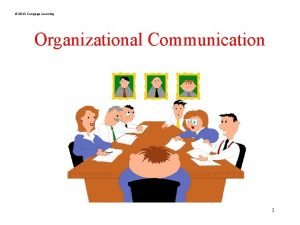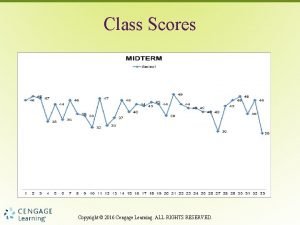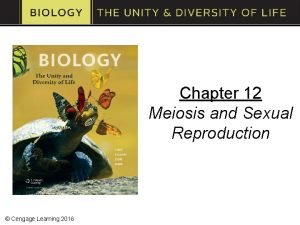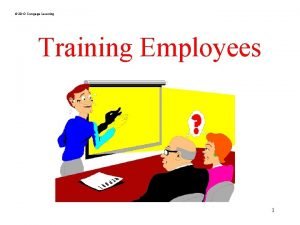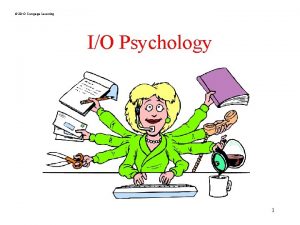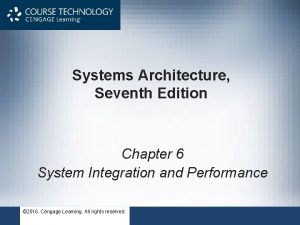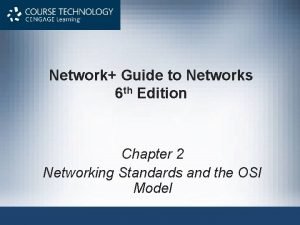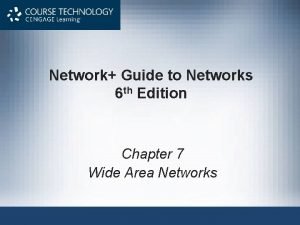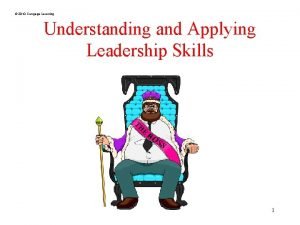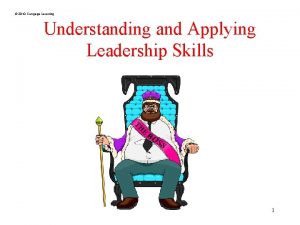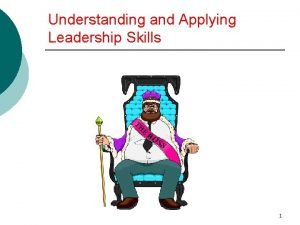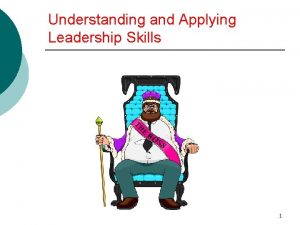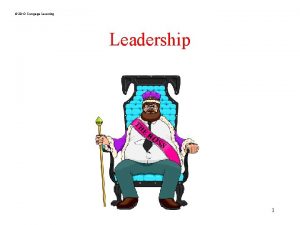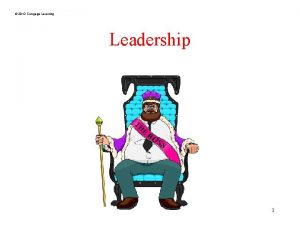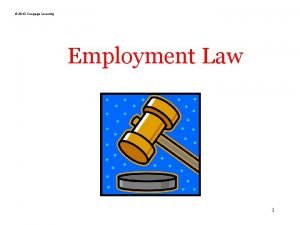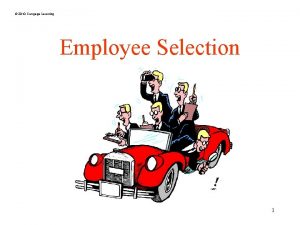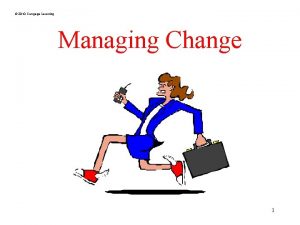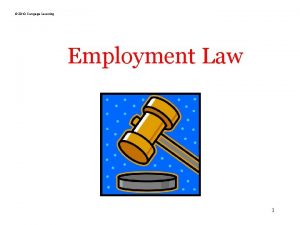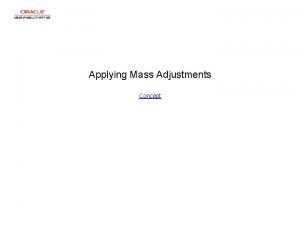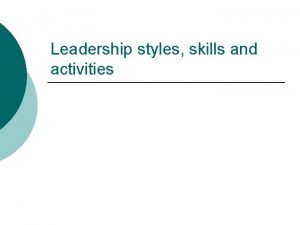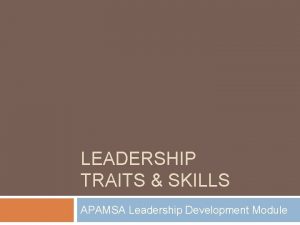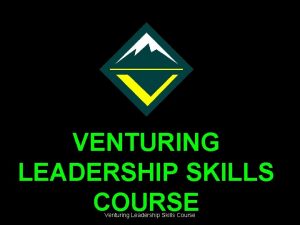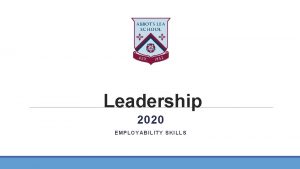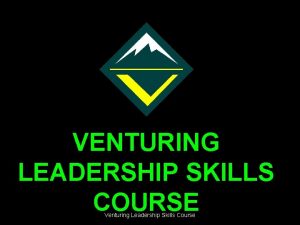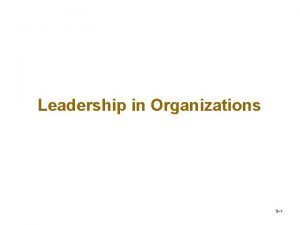2010 Cengage Learning Understanding and Applying Leadership Skills

































- Slides: 33

© 2010 Cengage Learning Understanding and Applying Leadership Skills 1

© 2010 Cengage Learning Thinking about Leadership Exercise 12. 1 2

© 2010 Cengage Learning How are leaders and managers, different? 3

© 2010 Cengage Learning 4

© 2010 Cengage Learning Leadership Characteristics Leader Emergence • Traits – – – Intelligence Openness to experience Extraversion Conscientiousness Emotional stability High self-monitoring • Leadership emergence seems to be stable across the life-span 5

© 2010 Cengage Learning Leadership Characteristics Leader Emergence • Motivation to Lead – Affective identity motivation • Experienced, enjoy being in charge and leading – Noncalculative motivation • Seek leadership positions resulting in concrete gains – Social normative motivation • Become leaders out of sense of commitment or duty 6

© 2010 Cengage Learning Leadership Characteristics Leader Performance • Traits: Big 5, Cognitive Ability • Needs: Nach; Leadership Motive Pattern – High need for power and low for affiliation • Gender • Task- versus person- orientation • Unsuccessful leaders-Lack of training, cognitive deficiencies, paranoid, passive aggressive, narcissist. 7

© 2010 Cengage Learning Traits • • • Intelligence Charisma Dominance Energy Extraversion Openness to experience Agreeableness Emotional stability Self-monitoring 8

© 2010 Cengage Learning Individual Differences and Leader Emergence and Performance Corrected Correlations Trait Emergence Performance Meta-analysis Personality Neuroticism -. 24 -. 22 Judge et al. (2002) Extraversion . 33 . 24 Judge et al. (2002) Openness . 24 Judge et al. (2002) Agreeableness . 05 . 21 Judge et al. (2002) Conscientiousness . 33 . 16 Judge et al. (2002) Self-monitoring . 21 Intelligence Need for Ach . 25 Day et al. (2002). 27 Judge et al. (2004) . 23 Argus & Zajack (2008) 9

© 2010 Cengage Learning Needs • Types of Needs – Power – Achievement – Affiliation • Leadership Motive Pattern – High need for power – Low need for affiliation 10

© 2010 Cengage Learning Task Versus Person Orientation • Person-Oriented Leaders – act in a warm, supportive manner and show concern for the employees – believe employees are intrinsically motivated • Task-Oriented Leaders – set goals and give orders – believe employees are lazy and extrinsically motivated 11

© 2010 Cengage Learning Relationship Among Theories Person Orientation High Country club (MG) Consideration (OS) Theory Y Team (MG) Middle-of-the-Road (MG) Low Task-centered (MG) Initiating structure (OS) Theory X Impoverished (MG) Low High Task Orientation 12

© 2010 Cengage Learning Consequences of Leader Orientation 13

© 2010 Cengage Learning Unsuccessful Leaders (Hogan, 1989) • Lack of training • Cognitive deficiencies • Personality problems – paranoid/passive-aggressive – high likeability floater – narcissist 14

© 2010 Cengage Learning Unsuccessful Leader Behavior Shen et al. (2008) • Engaging in illegal and unethical behavior • Avoiding conflict and people problems • Demonstrating poor emotional control (e. g. , yelling and screaming) • Over-controlling (e. g. , micromanaging) • Demonstrating poor task performance • Poor planning, organization, and communication • Starting or passing on rumors or sharing confidential information • Procrastinating and not meeting time commitments • Failing to accommodate the personal needs of subordinates • Failing to nurture and manage talent 15

© 2010 Cengage Learning Interaction Between the Leader and the Situation • • Situational Favorability Organizational Climate Subordinate Ability Relationships with Subordinates 16

© 2010 Cengage Learning Situational Favorability Fiedler’s Contingency Model • Least-Preferred Coworker Scale • Situation Favorability – high task structure – high position power – good leader-member relations • High LPC leaders best with moderate favorability and Low LPC leaders best with low or high favorability 17

© 2010 Cengage Learning Relationship Between LPC Scores and Group Success High LPC Score Low Performance High Performance Low LPC Score High Performance Low Performance High Performance Low Moderate High Situation Favorability 18

© 2010 Cengage Learning Organizational Climate IMPACT Theory • Leadership Style – – – Information Magnetic Position Affiliation Coercive Tactical • Ideal Climate – – – Ignorance Despair Instability Anxiety Crisis Disorganization 19

© 2010 Cengage Learning IMPACT Leadership Strategies • Find a climate consistent with your leadership style • Change your leadership style to better fit the existing climate • Change your followers’ perception of the climate • Change the actual climate 20

© 2010 Cengage Learning Subordinate Ability Path-Goal Theory • Instrumental style – plans, organizes, controls • Supportive style – shows concern for employees • Participative style – shares information and lets employees participate • Achievement-oriented style – sets challenging goals and rewards increases in performance 21

© 2010 Cengage Learning Subordinate Ability Situational Leadership Theory 22

© 2010 Cengage Learning Relationships with Subordinates Leader-Member Exchange (LMX) Theory • Concentrates on the interactions between leaders and subordinates • Subordinates fall into either the: – in-group (high quality relationship) – out-group (low quality relationship) • In-group employees – – More satisfied Higher performance Less likely to leave OCBs 23

© 2010 Cengage Learning Leader Behaviors (Yukl, 1982; Carter, 1952; Hemphill & Coons, 1950 & Gibbs, 1969) Specific Skills Theory • • • Organizing Analysis and decision making Planning Communication Delegation Carefulness Toughness Integrity Listening 24

© 2010 Cengage Learning Leadership Through Decision Making • Vroom-Yetton Model – Tells the process to go through to make a decision in a situation 25

© 2010 Cengage Learning 26

© 2010 Cengage Learning Leadership Through Contact • Management by walking around (MBWA) – Increasing communication, building relationship and encouraging employee participation 27

© 2010 Cengage Learning Leadership Through Power • Expert Power (knowledge) • Legitimate Power (position) • Reward Power (control over financial and non-financial rewards) • Coercive Power (punishment) • Referent Power (being well liked, friendly) 28

© 2010 Cengage Learning Leadership Through Vision Transformational Leadership • • Visionary (what future looks like) Differentiation (charisma) Values (strong) Transmission of vision and values (using more imagery) • Flaws (makes them more human) 29

© 2010 Cengage Learning Leadership Through Vision Authentic Leadership • Reflecting own ethics beliefs and values • Self reflecting • Introspective • Self-awareness • High self esteem 30

© 2010 Cengage Learning Cross Cultural Leadership. PROJECT GLOBE • Charismatic (vision) • Self-protective (assertive, following procedure, face saving) • Humane (helping) • Team oriented (collaborative) • Participative (getting opinions) • Self Autonomous (independent) 31

© 2010 Cengage Learning Putting all theories together • Leader Behaviors & Traits – Big 5, Cognitive Ability • Situation Characteristics – Fielder, IMPACT theory • Follower Characteristics – Path goal, LMX, Situational Leadership 32

© 2010 Cengage Learning Applied Case Study: Developing leaders at Claim Jumper Restaurants 33
 2010 cengage learning
2010 cengage learning Chapter 6:2 interpreting word parts
Chapter 6:2 interpreting word parts Chapter 5 the cardiovascular system labeling exercises
Chapter 5 the cardiovascular system labeling exercises Cengage learning heart diagram
Cengage learning heart diagram South-western cengage learning
South-western cengage learning Chapter 13 medical math assignment sheet
Chapter 13 medical math assignment sheet 2009 delmar cengage learning
2009 delmar cengage learning Cengage learning heart diagram
Cengage learning heart diagram 2009 delmar cengage learning
2009 delmar cengage learning Cengage learning australia
Cengage learning australia Measuring and recording apical pulse
Measuring and recording apical pulse Cengage learning
Cengage learning Cengage learning
Cengage learning Wadsworth cengage learning
Wadsworth cengage learning Cengage learning
Cengage learning Cengage learning plant cell
Cengage learning plant cell Cengage learning
Cengage learning Cengage learning
Cengage learning Brooks cole cengage learning
Brooks cole cengage learning Chapter 7 cengage
Chapter 7 cengage 2014 cengage learning accounting answers
2014 cengage learning accounting answers Cengage chapter 7
Cengage chapter 7 Cengage learning
Cengage learning Cengage learning
Cengage learning 2009 delmar cengage learning
2009 delmar cengage learning Cengage learning
Cengage learning Chapter 10 cultural diversity
Chapter 10 cultural diversity Cengage learning
Cengage learning 2012 cengage learning
2012 cengage learning Solomon four group design
Solomon four group design Cengage learning psychology
Cengage learning psychology Course technology cengage learning
Course technology cengage learning Course technology cengage learning
Course technology cengage learning Course technology cengage learning
Course technology cengage learning
